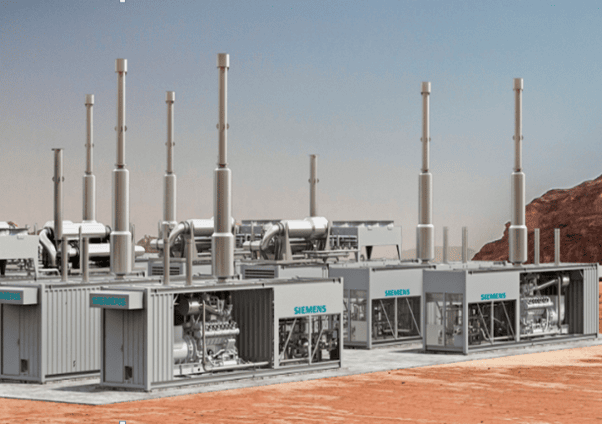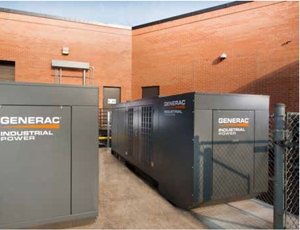February 2019 Articles:
- POWER MATTERS TO MEMORY CARE FACILITIES
- CYBERLINK BREATHES EASY WITH GENERAC RELIABILITY
- UNDERSTANDING NATURAL GAS FUEL RELIABILITY FOR BACKUP POWER
- ESSE OFFERS COMBINED HEAT & POWER (CHP) SYSTEMS
POWER MATTERS TO MEMORY CARE FACILITIES
According to the Alzheimer’s Association, about every minute, someone in the United States develops Alzheimer’s disease. The association said by 2050, someone will develop dementia from the illness every 33 seconds. The Centers for Disease Control and Prevention said Alzheimer’s is the most common cause of dementia in the United States and the sixth-leading cause of death. The disease is most common among the older population and about one in 10 seniors currently have dementia from Alzheimer’s disease. To help the population affected by this disease in Florida, CERTUS Senior Living is constructing new memory care facilities across the state.
“We felt like the memory care market was under served,” said Glen Pawlowski, chief executive officer, CERTUS. “It seemed like there were people, suffering from dementia, that weren’t doing well and we saw the need to help fill that void.”
The latest facility to open is CERTUS Premier Memory Care Living in Orange City. The building is 43,000 square feet, with 64 private bedroom suites. CERTUS is known for their unique approach to community design and they focus on building communities that are unique to the industry and complements the very best care, engagement and safety for both residents and associates.
“Our goal is to make every day a good day,” said Pawlowski. “We want to create the best environment possible by providing a highly trained staff who can assist the residents in any way in day-to-day tasks. If we are going to provide a service, we are going to be completely immersed and all in.”
Designing an Assisted Living Facility (ALF) in Florida requires extra considerations to keep residents safe. In the case of an emergency, all facilities must have ample resources, including a generator, for climate control. “In the event of a hurricane or storm, we wanted to shelter in place,” said Pawlowski. “The last thing we want to do is evacuate and cause undue stress to our residents. In the past, storms have knocked out power for days and we need to be able to provide services requiring power continuously. Securing a generator was always a priority.”
When the power is out for a prolonged period, several things can happen;
- Food spoils
- Air conditioning goes out
- Medical devices fail
- Security systems go down
- Drinking water becomes scarce
Having a generator in place can prevent these from happening. Generators can provide backup power to the entire building, so if the power goes out, all functions throughout the building will remain operational. Life safety systems are highly important to an ALF, and so are climate control systems, an operational kitchen, and anywhere residents are. Being a memory care facility, keeping security systems running was a big concern for CERTUS.
According to the Alzheimer’s association, six in ten people with dementia will wander. A person with Alzheimer’s disease may not remember their name and they may become disoriented, even in familiar places. “Some of our residents are a flight risk,” said Pawlowski. “Their safety would be in jeopardy if the power went out.” CERTUS has devices that signal when a door or window is opened. If the power were to go out, staff would not be alerted if a resident had left the building.
To protect residents, CERTUS installed a Generac 390 kW Modular Power System (MPS). The MPS solution consisted of three paralleled 130 kW natural gas generators. “By getting three smaller units in a series, we were guaranteed to have uninterrupted service,” said Pawlowski. He said even in the event two units are offline for maintenance, life safety systems will still be supported.
Pawlowski said his emergency power solution is something he can depend on. “Our Generac generators do their job and we do not have to think about it. That is all I could have hoped for in a solution.”
CYBERLYNK BREATHES EASY WITH GENERAC RELIABILITY
For the United States as a whole, natural gas provided 32% of total electricity generation in 2017, which is slightly higher than coal’s 30% share according to the U.S. Energy Information Administration (EIA). EIA reported that natural gas generated 1,378,307,000 megawatts compared to 1,239,149,000 for coal.
“In 2017, coal provided the largest generation share in 18 states, down from 28 states in 2007 while natural gas had the largest share in 16 states, up from 11 in 2007,” said EIA in its Sept. 10, 2018 report.
The U.S. is currently the world’s largest natural gas producer, having surpassed Russia in 2009. According to EIA, natural gas production in the U.S. has jumped from 55 billion cubic feet per day (Bcf/d) in 2008 to average 73.6 Bcf/d in 2017.
Gas electricity generation has continued to grow, as prices have been relatively low and production continues to rise. The market-driven response to low prices and new environmental regulations favors natural gas along with renewable energy sources like solar and wind.
The use of diesel generator sets as the primary choice for reliable temporary on-site power generation is falling. With several practical benefits – including reduced maintenance costs and emissions as well as enhanced accessibility – natural gas is quickly becoming the fuel of choice for a variety of industrial power applications.
Diesel engine emissions from stationary sources are part of a larger group of U.S. Environmental Protection Agency (EPA) air quality regulations. Ultra-low sulfur diesel (ULSD) fuel was a prerequisite for engine exhaust aftertreatment systems introduced after 2006, enabling engines to achieve exhaust emissions more than 99% cleaner than engines manufactured prior to 1996. However, ULSD has a shorter shelf life compared to its high-sulfur predecessor. On-site diesel storage tanks are typically sized to provide 12 to 72 hours of run time, and fuel polishing is required every six to 24 months.
NFPA 100 also requires fuel to be remediated as necessary. According to NFPA 110, fuel tanks that are subject to temperature variations can experience accelerated fuel degradation, especially if the tanks are outside and above ground. The presence of water can lead to microbiological contamination and growth, which in turn can lead to general pitting corrosion of steel tanks and components, possibly resulting in filter plugging, operational issues or a hydrocarbon release into the environment.
With ULSD requiring more rigorous maintenance for the fuel itself coupled with the EPA’s mandate for cleaner-burning diesel engines that require a higher quality fuel, diesel fuel is no longer the low-cost, low-maintenance emergency fuel it had been.
By comparison, natural gas generators avoid those fuel supply and maintenance issues. According to a 2013 report by Massachusetts Institute of Technology’s Lincoln Laboratory, natural gas distribution systems operate at a reliability rate exceeding 99.999%, with the exception of seismically active areas. Incidentally, that makes the natural gas distribution system approximately one-thousand times more reliable than a single engine generator set, which is typically assumed to be 99% reliable.
The same MIT report notes that many of the compressors on the transmission network are powered by natural gas, using approximately 3% of the natural gas produced. The distributed nature of the natural gas production and transmission networks result in an exceedingly low probability of cascading failure.
For those who require emergency power systems, natural gas addresses all their concerns: cleaner exhaust emissions, equal or better fuel availability, reduced fuel maintenance and reduced environmental liability. According to the EIA, from an end user’s perspective, natural gas is delivered on demand, and it is easy to overlook more than four-trillion cubic feet of storage in the continental United States. If all natural gas production in the United States ceased simultaneously, it would still take anywhere from two to nine weeks to fully deplete the natural gas in underground storage.
When choosing a fuel source for a backup power solution, working with us is an important step in ensuring the ideal products are specified to meet the city, state and national codes as well as the needs of the customer. Contact us with any questions.
UNDERSTANDING NATURAL GAS FUEL RELIABILITY FOR BACKUP POWER
INTRODUCTION
Reliability of fuel supply tends to be of great concern for authorities having jurisdiction (AHJs). On-site fuel (most often diesel) is typically required for life-safety applications, and many mission-critical applications like 911 call centers specify it because it is perceived to be more reliable. Nonetheless, maintenance issues and delivery concerns of diesel fuel in an emergency, combined with the reliability and cost effectiveness of natural gas, must be considered in a standby power system. NFPA and NEC offer provisions for the use of natural gas in standby power applications that had previously been the clear domain of diesel-fueled systems. There are also many ways to work with the AHJ to clear the way for the use of gaseous fuel in a standby power system.
Historically, choosing between diesel-fueled and natural gas-fueled gensets has been relatively clear-cut. Power density, large-kW application cost advantages, and perceptions of reliability have made diesel the primary fuel of choice for large commercial and industrial standby applications.
However, natural gas-fueled gensets are becoming more powerful and more cost effective. Fuel storage, environmental, and diesel delivery issues are making system designers, electrical contractors, and electrical engineers as well as owners and operators seek alternatives to diesel-fueled gensets.
When selecting or specifying either gaseous- or diesel-fueled gensets, however, one must consider the reliability of the fuel infrastructure, regulatory issues, and how local authorities perceive and regulate these fuel choices.
TRADITIONAL APPROACHES TO FUEL RELIABILITY
Reliability of fuel supply tends to be of great concern for authorities having jurisdiction (AHJs). Typically, AHJs require the use of on-site fuel for facilities that are categorized as NFPA 110, Level 1 loads; these are defined as backup power systems installed “where failure of the equipment to perform could result in loss of human life or serious injuries.” NFPA 110 Level 1 loads are typically associated with NFPA 70: National Electrical Code (NEC), Article 700: Emergency Systems. Mission-critical applications like these, which include hospitals and 911 call centers, rely on diesel-fueled generators because on-site fuel storage is perceived to be more reliable.
While NEC requires an on-site fuel supply for mission-critical and legally-required standby systems, it allows the AHJ to permit the use of other than on-site fuels in applications that have a low probability of a simultaneous failure of both the off-site fuel delivery system and the power from the outside electrical utility company. However, storing diesel fuel on-site is seen as increasing the reliability of backup power in non code-required applications, and makes it possible to provide backup power in remote areas that do not have access to a gaseous-fuel infrastructure.
Traditions are typically hard to break, which could explain why many AHJs continue to require diesel-fueled gensets. Diesel has been the traditional fuel of choice for backup and standby gensets. Historically, the use of diesel as a fuel for gensets has been a long-standing, proven technology. Because of this, the perception within the market is that diesel engines are the most reliable prime movers for backup power applications.
DIESEL FUEL CONCERNS
While many users may prefer diesel as a genset fuel, several issues associated with diesel should be considered. Annex A of NFPA 110 identifies several considerations associated with diesel fuel. For example, temperature variations can accelerate fuel degradation. Prolonged exposure to ambient air can cause diesel fuel to oxidize. Ambient temperature changes can lead to condensation within the fuel tanks. The water from this condensation can lead to microbiological contamination and growth, which in turn can cause corrosion of steel tanks and components, filter plugging, operational issues, or a hydrocarbon release to the environment.
For these reasons, facility managers must be diligent in maintaining their generators’ diesel fuel supply. Even in ideal cases, diesel fuel has a shelf life of less than 12 months, at which time the fuel must be polished (filtration and water removal) or replaced. Ultra-low-sulfur fuel is particularly prone to fuel breakdown, because the extra refining steps required to remove sulfur also remove some of the elements that keep the fuel stable.
Despite their widespread use, diesel-fueled gensets are vulnerable to events that could cripple transportation infrastructures, making refueling problematic—or perhaps even impossible. Hurricanes and severe storms can close roads. Grid failures can make it impossible for suppliers to pump fuel into delivery trucks. For example, Hurricane Sandy, which slammed into the Northeastern U.S. in late October of 2012, caused significant damage to fuel distribution infrastructure. Fuel distribution networks were paralyzed. Critical terminals for petroleum and petroleum products were badly damaged. Many service stations lost power and couldn’t pump gas or diesel fuel. Whereas diesel gensets can operate reliably during extended outages, users can’t always count on the availability of diesel fuel and deliveries.
RELIABILITY OF THE NATURAL GAS INFRASTRUCTURE
While weather, human-caused disasters, and even labor issues such as strikes can impact diesel fuel delivery and availability, the natural gas utility infrastructure is generally reliable. Typically, factors that tend to impact the electrical infrastructure do not impact the natural gas infrastructure. In most cases, natural gas is delivered by underground pipelines that are usually not affected by severe weather that can cause electrical power outages.
According to Platts, the natural gas supply throughout the Northeast U.S. was not interrupted during Hurricane Irene, which hit the U.S. in late August, 2011. A check of natural gas pipelines throughout the Northeast area showed no notices of service interruptions or other issues.
An analysis of the Northeast snowstorm that occurred in late October, 2011 by the Federal Energy Regulatory Commission (FERC) and the North American Electric Reliability Corporation (NERC) showed that more than 3 million customers lost electric power. However, the analysis made no mention of any natural gas infrastructure interruptions.
After Hurricane Sandy, New Jersey Natural Gas reported that it was shutting off service to about 28,000 customers because of storm damage. However, the number affected by this outage was only a fraction of the nearly 2 million New Jersey customers without electrical power.
Using natural-gas-fueled gensets instead of diesel-fueled gensets depends on the intended application. What this means is that, unless the AHJ allows otherwise, mission-critical applications require on-site fuel storage, or diesel. However, for non coderequired applications, natural gas can be a viable option. Storage is not an issue because natural gas is supplied continuously by the local municipal infrastructure. This means that this continuous supply extends genset run time.
REGULATORY ISSUES
Numerous NFPA codes and standards apply to standby generators. NFPA 110 and the NEC are the most frequently referenced standards for ensuring safe, reliable, and compliant genset specification, installation, commissioning, and operation. Most of the requirements applicable to genset fuel refer to diesel-powered units. However, there are provisions and exceptions associated with natural gas-powered units.
According to NFPA 110, Article 5.1.1(3), natural gas is an acceptable fuel for an emergency power system. However, the exception that immediately follows states: “For Level 1 installations in locations where the probability of interruption of off-site fuel supplies is high, on-site storage of an alternate energy source sufficient to allow full output of the EPSS to be delivered for the class specified shall be required.”
While most of NFPA 110 applies to diesel fuel delivery, storage, and quality requirements, Article 7.9 includes specific requirements for natural gas:
7.9.7—Where the gas supply is connected to the building gas supply system, it shall be connected on the supply side of the main gas shutoff valve and marked as supplying an emergency generator.
7.9.8—The building’s main gas shutoff valve shall be marked or tagged to indicate the existence of the separate EPS shutoff valve.
7.9.9—The fuel supply for gas-fueled and liquid-fueled prime movers shall be designed to meet the demands of the prime mover for all of the following factors:
(1) Sizing of fuel lines
(2) Valves, including manual shutoff
(3) Battery-powered fuel solenoids
(4) Gas regulators
(5) Regulator vent piping
(6) Flexible fuel line section
(7) Fuel line filters
(8) Fuel vaporizers (LP-Gas)
(9) Ambient temperature effect of fuel tank vaporization rates of LP-Gas where applicable.
While NFPA 110 has plenty to say about genset fuel systems, the NEC has very little. NEC, Article 700.12(B)(3) states: “Prime movers shall not be solely dependent on a public utility gas system for their fuel supply.” However, the exception that immediately follows states: “Where acceptable to the authority having jurisdiction, the use of other than on site fuels shall be permitted where there is a low probability of a simultaneous failure of both the off-site fuel delivery system and power from the outside electrical utility company.”
ADDRESSING NATURAL GAS RELIABILITYWITH THE AHJ
The AHJ has the final say regarding genset applications. Therefore, consulting the AHJ regarding the reliability of the genset’s fuel supply is a must.
Because of its availability, many AHJs prefer on-site fuel storage, meaning diesel fuel. It is generally required by the NEC, Article 700 in many municipalities. However, convincing the AHJ to consider approving the use of natural gas-fueled gensets may be quite challenging. While most AHJs do not have to be convinced that diesel fuel is reliable, providing proof that the natural gas fuel source is reliable may open eyes and change minds.
One way to convince the AHJ to consider natural gas is to get the utility to certify reliability. The reliability of a natural gas fuel source can be proven with a letter from the natural gas vendor that contains:
- A statement that the fuel source is reasonably reliable
- A description supporting the assertion that the source is reasonably reliable
- A statement of the low likelihood of an interruption
- A description supporting the assertion that the likelihood of interruption is low
- A signature from technical personnel
Working with both the local gas utility and the AHJ can help engineers, owners, and operators understand the reliability of the natural gas supply as it compares to on-site diesel fuel. Ensuring that the facility is not subject to curtailment policies can help prevent natural gas fuel supply interruptions.
Another way to alleviate discussions about the reliability of on-site vs. utility-supplied natural gas is to consider a system that uses both fuels—individually or simultaneously. Bi-fuel gensets, for example, run on both diesel fuel and natural gas and leverage the benefits of each while minimizing their respective drawbacks.
Bi-fuel gensets combine the power density and capital cost benefits of diesel engines with the extended run time of natural gas. These units start up on diesel fuel, which helps gensets meet the 10-second startup requirements for mission-critical facilities. As loads are added, natural gas is introduced and increased while diesel fuel is decreased. Typically, bi-fuel gensets operate on up to 75% natural gas, 25% diesel with no reduction in power under typical load conditions. However, bi-fuel units will not run on 100% natural gas.
Because less diesel fuel is consumed, run times are significantly extended, which could be a significant issue during emergencies that challenge municipal infrastructures, thereby affecting diesel fuel deliveries. With natural gas as the predominant fuel, diesel tanks can be smaller, which reduces the risk of fuel contamination as well as the cost of maintaining diesel fuel.
Bi-fuel gensets are only slightly more expensive than diesel-only units. Also, fuel redundancy is built in. In the unlikely event that the natural gas supply is interrupted, or if there is a fault in the bi-fuel delivery system, the genset controls automatically revert to all-diesel operation without interruption.
CONCLUSION
For decades, diesel has been the traditional fuel of choice for commercial and industrial backup and standby gensets. However, today, diesel is not the only option. Now, engineers, owners, and operators have genset fuel choices, each of which offers unique benefits.
Take time to learn how these genset fuel choices can be applied to ensure that the best solutions are selected. Also, consult the local AHJ to understand the policies on using particular fuels in given applications.
ESSE OFFERS COMBINED HEAT & POWER (CHP) SYSTEMS





